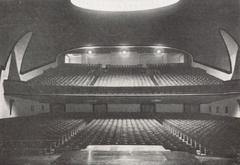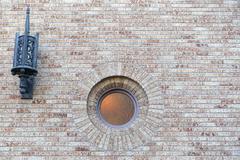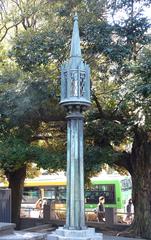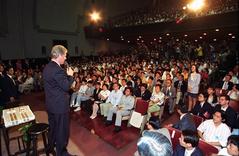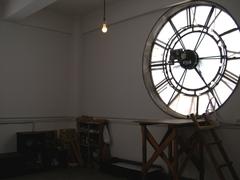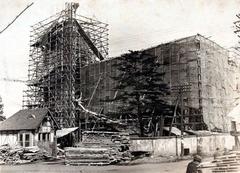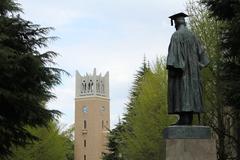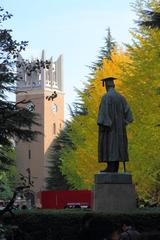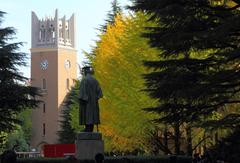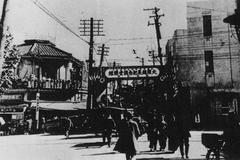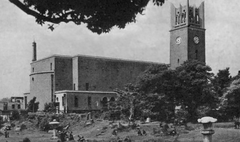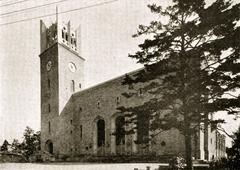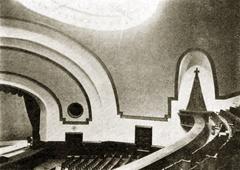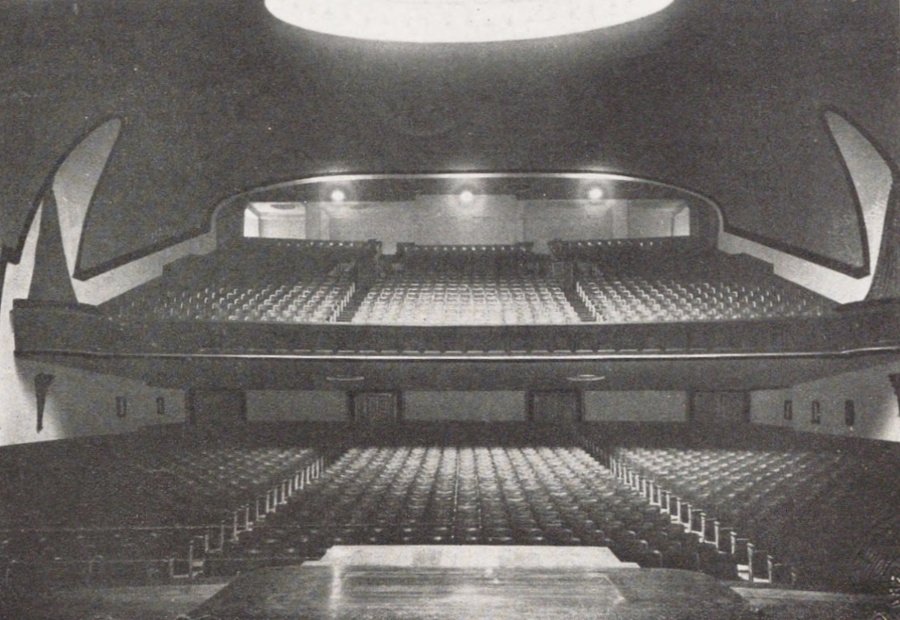
Ōkuma Auditorium Tokyo: Visiting Hours, Tickets, and Travel Guide
Date: 14/06/2025
Introduction: History and Cultural Significance
Located in the heart of Tokyo’s Shinjuku district, Ōkuma Auditorium is a renowned landmark and architectural centerpiece of Waseda University. Built in 1927 to celebrate the university’s 45th anniversary, it commemorates founder Shigenobu Ōkuma—a pivotal figure in Japan’s modernization. The auditorium is celebrated for its blend of Western Tudor Gothic and traditional Japanese styles, symbolizing Japan’s intellectual aspirations during the Taishō and early Shōwa eras (Waseda University History; Wikiwand).
With its striking 125-foot clock tower—a nod to Ōkuma’s vision of a “life of 125 years”—the auditorium is both the physical and symbolic heart of Waseda’s campus. It hosts major academic events, international symposia, and cultural performances, fostering a vibrant exchange of ideas and traditions (Waseda Architecture History).
This guide provides detailed visitor information—including hours, tickets, accessibility, and tours—while exploring the building’s history, design, and ongoing cultural impact. Whether you’re drawn by its architecture, history, or role in campus life, this guide will help you plan your visit to one of Tokyo’s most significant historical landmarks (Waseda University Facilities; Wikiwand).
Table of Contents
- Historical Context and Architectural Overview
- Distinctive Features and Symbolism
- Wartime Survival and Postwar Restoration
- Cultural Heritage Status and Preservation
- Visiting Information: Hours, Tickets, and Tours
- Accessibility and Visitor Amenities
- Travel Tips and Nearby Attractions
- Integration with Campus Life
- Role in Japanese Heritage
- Frequently Asked Questions (FAQ)
- Conclusion and Planning Resources
Historical Context and Architectural Overview
Ōkuma Auditorium, also known as Ōkuma Kōdō, is named for Waseda University’s founder and former Prime Minister, Shigenobu Ōkuma. The university was established in 1882 as Tokyo Senmon Gakkō to foster global-minded leaders. The auditorium, completed in 1927, was designed by Kōichi Satō with influence from President Sanae Takada, who specifically requested a Gothic design to honor Ōkuma’s legacy (Waseda University History; Wikiwand).
Its architectural style is a rare example of Tudor Gothic in Tokyo, with pointed arches, verticality, and decorative stonework reflecting European academic tradition. The building’s design also incorporates Japanese materials and sensibilities, representing the nation’s early 20th-century modernization.
Distinctive Features and Symbolism
Clock Tower and Architectural Details
The auditorium’s most striking feature is its seven-story, 125-foot clock tower, a symbolic reference to Ōkuma’s “life of 125 years” philosophy (Wikiwand). The façade’s brick and stone, pointed arches, and Gothic ornamentation evoke the great universities of Europe. The main hall seats 1,123 people; a smaller auditorium in the basement accommodates 301 guests.
Symbolic Elements
The elliptical transom windows on the roof represent the sun, moon, and nine traditional planets, symbolizing universal harmony (Wikiwand). The clock tower houses four bells imported from the United States, tuned to echo the chimes of London’s Palace of Westminster. These bells sound six times daily, marking key moments in campus life.
European Influences
Design inspirations include Stockholm City Hall, Kronborg Castle, and Oxford’s Carfax and Magdalen Towers, reflected in the building’s massing, verticality, and use of towers (Wikiwand).
Wartime Survival and Postwar Restoration
Ōkuma Auditorium survived World War II air raids, a testament to its robust construction. After the war, it became a symbol of resilience and national renewal. Major renovations in 2006–2007 modernized the building while preserving its historic character, enhancing accessibility and safety (Waseda Architecture History).
Cultural Heritage Status and Preservation
Designated an Important Cultural Property by both the Tokyo Metropolitan Government and the national Agency for Cultural Affairs, the auditorium is protected by strict preservation standards (Wikiwand). The Department of Architecture at Waseda University oversees its maintenance, ensuring that it remains a living example of early 20th-century Japanese architecture (Japan Heritage Policy).
Visiting Information: Hours, Tickets, and Tours
Visiting Hours
Ōkuma Auditorium is primarily accessible during university events, open days, and guided tours. Public visiting hours typically run from 9:00 AM to 5:00 PM during these occasions, but schedules may vary. Always check the official Waseda University website for the latest information.
Tickets and Entry
General admission is free during open days and many events. Some cultural performances or lectures may require tickets, which can be reserved online or at the venue. The 125th Anniversary Room and exhibition spaces are free to enter during their open hours (Waseda University Facilities).
Guided Tours
Guided tours, led by staff or volunteers, offer insights into the auditorium’s architecture and history. These are offered periodically and require advance reservation due to limited slots. Details are published on the university’s website and event pages.
Photography
Photography is permitted in public and exhibition areas unless otherwise specified. Restrictions may apply during official ceremonies and performances.
Accessibility and Visitor Amenities
Ōkuma Auditorium is wheelchair accessible, featuring ramps and elevators. Restrooms, cloakrooms, and information desks are available during major events. Free Wi-Fi is provided on campus (Go Tokyo). For visitors with specific needs, contacting the university in advance is advised.
Travel Tips and Nearby Attractions
- Getting There: The auditorium is a short walk from Waseda Station (Tokyo Metro Tozai Line). Bus and taxi options are available.
- Nearby Attractions: Okuma Garden (historic Japanese garden adjacent to the auditorium), Yayoi Kusama Museum, St. Mary’s Cathedral, Gokoku-ji Temple, and the lively Shinjuku district (Trek Zone).
- Best Seasons: Spring and autumn offer the most pleasant weather and scenic campus views.
Integration with Campus Life
Ōkuma Auditorium is the ceremonial heart of Waseda University, hosting matriculation, graduation, symposia, and public lectures. It is open to the local community for concerts and exhibitions, reflecting Waseda’s commitment to cultural exchange and public engagement.
Role in Japanese Heritage
As part of the Japan Heritage initiative, Ōkuma Auditorium showcases Japan’s educational and architectural history. Its preservation and continued use reinforce the nation’s commitment to cultural continuity and innovation.
Frequently Asked Questions (FAQ)
Q: When can I visit Ōkuma Auditorium?
A: Public access is primarily during university events, open days, and guided tours. Confirm current schedules on the official website.
Q: Is there an entrance fee?
A: Admission is usually free during public events and for the 125th Anniversary Room. Some performances or lectures may require tickets.
Q: Are guided tours available?
A: Yes, guided tours are periodically scheduled. Advance booking is recommended.
Q: Is Ōkuma Auditorium accessible?
A: The building is fully accessible, with ramps, elevators, and support for visitors with disabilities.
Q: Can I take photographs?
A: Photography is generally allowed in public and exhibition areas, but may be restricted during specific events.
Q: How do I reach the auditorium by public transport?
A: The closest station is Waseda Station (Tokyo Metro Tozai Line), about a 5–10 minute walk from campus.
Conclusion and Planning Resources
Ōkuma Auditorium is more than an architectural landmark—it is a living testament to Japan’s educational progress, cultural exchange, and resilience. Its Tudor Gothic design, soaring clock tower, and symbolic features make it a must-see for anyone interested in history, architecture, or Japanese culture.
Plan your visit by checking the latest details on hours, tickets, and events. Enrich your experience by exploring Okuma Garden and nearby attractions in Shinjuku. For the most current information, consult the official resources below and consider downloading the Audiala app for event alerts and guided tour bookings.
References and Official Links
- Waseda University History
- Wikiwand: Okuma Auditorium
- Waseda University News - Okuma Auditorium
- Waseda University Culture Portal
- Go Tokyo - Tourist Information
- Japan Heritage Policy
- Trek Zone: Okuma Auditorium
- Waseda Architecture History
